Table of Contents
The first time I tasted shrimp bisque was on a rainy evening in a small coastal town. The warmth of that velvety bowl took me to a place of comfort and luxury. This elegant French dish turns simple ingredients into something truly magical.
I’ve worked hard to perfect my own seafood soup recipe. I’ve tried many techniques to bring out the sweet flavors of shellfish. What makes a bisque special is using shellfish and finishing it with cream for that silky texture.
My kitchen fills with a delicious aroma when I make this dish. Friends and family gather, drawn by the promise of something comforting yet sophisticated. This creamy shrimp bisque recipe dish is impressive as a starter or satisfying as a main course, without needing to be a pro.
In this guide, I’ll share my secrets for choosing the best ingredients and techniques. By mastering these, you’ll make a soup that’s as good as the best restaurants—right in your own kitchen.
Key Takeaways
- True bisque must be made with shellfish to earn its name
- The silky texture comes from proper stock-making and finishing with cream
- This elegant soup works as both an impressive appetizer or satisfying main course
- Homemade bisque rivals restaurant quality when proper techniques are used
- The recipe balances rich creaminess with the natural sweetness of shellfish
- French culinary traditions inform the classic preparation methods
The Rich History of Shrimp Bisque
Shrimp bisque is a dish that shows the rich history of coastal cooking. It comes from French traditions. This creamy soup has evolved from a simple fisherman’s meal to a fancy dish in restaurants. Learning about its history helps us appreciate its rich flavors and old cooking methods.
Origins of Bisque in French Cuisine
The story of bisque starts in France’s coastal areas. Waste-conscious fishermen and their families found ways to use every part of the seafood they caught. They made sure to get as much flavor as possible from the shells.
The word “bisque” has an interesting history. Some think it comes from Biscay, a bay in France. Others believe it means “twice cooked,” because of how the shells are used in making the soup.
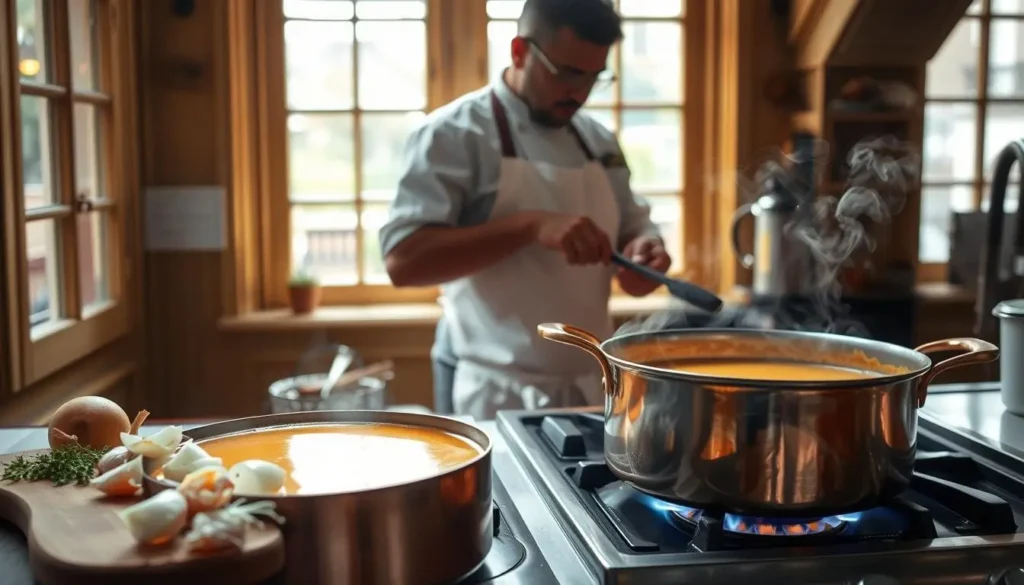
What makes a shrimp bisque special is how it gets flavor from the shells. French chefs crush the shells to get more flavor. This shell-based stock gives the soup its unique taste, which can’t be replicated easily.
By the 17th century, bisque was a favorite in French fancy cooking. The royal courts loved these soups, adding expensive ingredients like cream. But coastal areas kept making simpler versions, staying true to the dish’s roots.
Evolution of Shrimp Bisque in American Cooking
When French cooking came to America, bisque became popular along the coasts. The East Coast and Gulf Coast had plenty of shellfish, making shrimp bisque a hit. American chefs kept the basic method but added their own touches.
In New England, cooks added fresh herbs and sherry. Gulf Coast versions had bolder spices, showing the area’s love for spicy flavors. By the mid-20th century, shrimp bisque was a favorite in fine dining across America.
American bisque recipes are different from French ones. While French recipes stick to tradition, Americans like to try new things. Some use tomato paste for color and acidity, and others try different ways to thicken the soup.
| Characteristic | Traditional French Bisque | American Adaptation | Regional American Variation |
|---|---|---|---|
| Base Thickener | Rice or ground shells | Often flour roux | Okra (Gulf Coast) |
| Component | Sherry or white vinegar | ||
| Seasoning Profile | Subtle herbs (thyme, bay) | More pronounced spices | Cajun spice blend (Louisiana) |
| Texture | Extremely smooth, strained multiple times | Sometimes less refined | Chunky with visible shrimp (New England) |
| Color | Pale pink to beige | Often deeper orange-pink | Reddish (tomato-based versions) |
Today, shrimp bisque is a mix of French skill and American creativity. Modern chefs keep trying new things, but they always respect the natural taste of shrimp. This dish connects us to a long history of cooking.
Enjoying shrimp bisque in Paris or an American restaurant links us to a rich culinary tradition. The question “what is a traditional bisque?” might have different answers in France and America. But the goal of getting deep flavor from simple ingredients is the same everywhere.
Understanding What Makes a True Bisque
Exploring what makes a true bisque reveals a complex cooking process. It turns shellfish into a luxurious, velvety soup. Many use the term “bisque” loosely, but true bisque has specific standards.
Knowing these standards helps you appreciate the effort in making an authentic shrimp bisque. It also shows why shortcuts can lead to disappointing results.
Defining Characteristics of Bisque vs. Regular Soup
A true bisque is different from regular soups in several ways. First, authentic bisque must be shellfish-based. This comes from its French origins, where it referred to crustacean soups.
The texture of a proper bisque is smooth and velvety. Unlike chunky soups, bisque is made smooth through pureeing and straining. This process removes any fibrous bits, making it luxurious.
What makes a bisque different from soup is its richness. Cream is a key ingredient in bisque, adding flavor and texture. The soup starts with a shellfish stock, then gets enriched with cream.
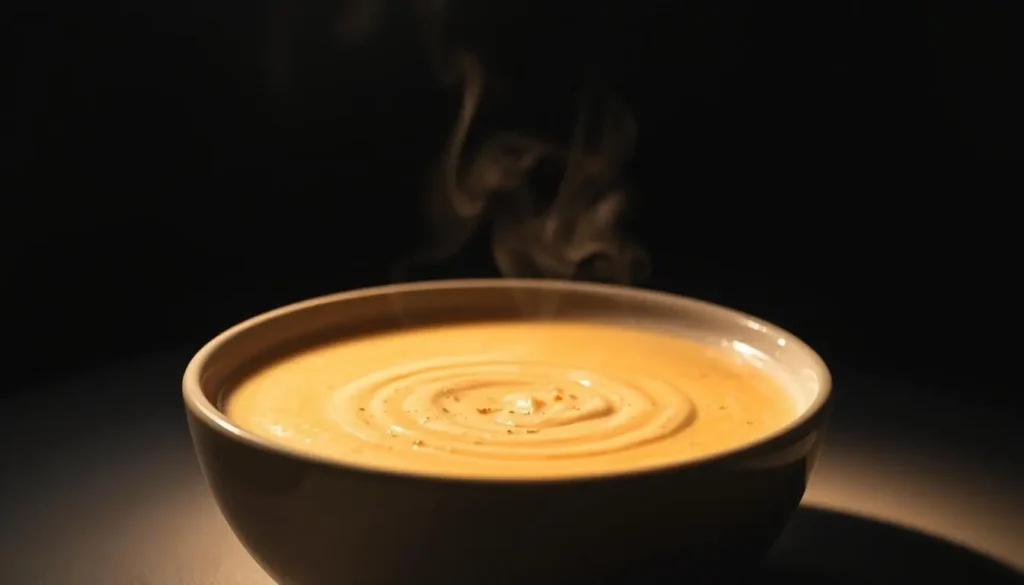
The Role of Shellfish in Traditional Bisques
Shellfish is the foundation of bisque. What is bisque sauce made of? It starts with shellfish and their shells, which give it a unique flavor. Any soup without this base is just a cream soup.
The shells of crustaceans add flavor and gelatin to bisque. In traditional French cooking, chefs grind the shells into the soup. This extracts all the flavors from the ingredients.
This process is why shrimp bisque tastes so intensely of shrimp. The shells contain compounds that enhance the flavor. When you taste a proper bisque, you’re experiencing the essence of the shellfish.
The gelatin from the shells makes the soup thick and velvety. This, combined with cream, creates the signature texture of bisque. It’s this combination that makes bisque special.
Understanding these principles shows why making bisque is more work than other soups. But the effort is worth it for a soup of unmatched richness and complexity. When making shrimp bisque at home, using traditional techniques will give you a true culinary experience.
Essential Ingredients for a Perfect Shrimp Bisque Recipe
Creating a perfect shrimp bisque requires top-notch ingredients. Each part plays a key role in the soup’s flavor. Let’s look at the must-haves for a memorable shrimp bisque.
Selecting the Best Shrimp
The star of any shrimp bisque is the shrimp. I suggest using medium to large shell-on shrimp. The shells are packed with flavor that’s essential for the soup.
Fresh shrimp add the best taste, but frozen can also be great. Choose shrimp with a mild smell and firm flesh. Avoid any with a strong ammonia smell or soft texture.
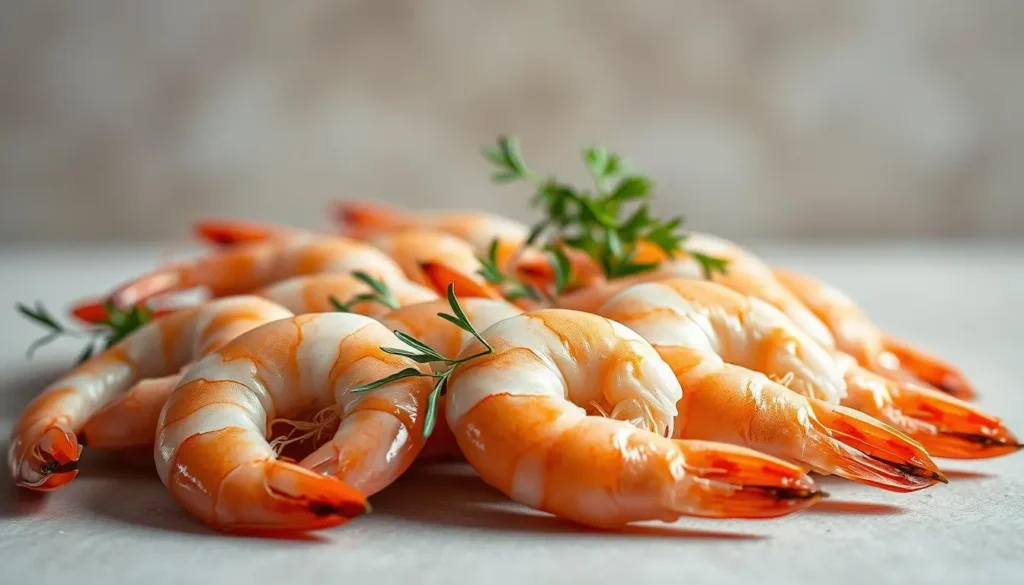
For a classic recipe, you’ll need about 4 pounds of shrimp shells. Wild-caught shrimp often have a richer flavor. But, either type works well. Make sure to remove the vein before cooking to avoid bitterness.
Key Aromatics and Vegetables
The base of a shrimp bisque is crucial. I start with onions, celery, and carrots, known as mirepoix. Yellow onions are best because they become sweet when cooked.
Fennel bulb is my secret for a great bisque. Its anise flavor complements seafood well. For herbs, use fresh thyme, parsley, and tarragon to enhance the shrimp taste.
Bay leaves add earthiness, and garlic brings a needed kick. Don’t forget the tomato paste for color and umami. For a 4-quart batch, you’ll need:
– 2 medium yellow onions, chopped
– 2-3 celery stalks, diced
– 1 small fennel bulb, sliced
– 2 medium carrots, diced
– 3-4 cloves of garlic, minced
– 2-3 tablespoons of tomato paste
Liquids and Dairy Components
Liquids turn your ingredients into a luxurious soup. Dry white vinegar or sherry brighten the flavor.
For a standard batch, ½ cup of white vinegar. These enhance the flavors of your ingredients.
The dairy makes the bisque creamy. Heavy whipping cream is traditional, but half-and-half can make it lighter. The key is finding the right balance between seafood stock and dairy.
Water is the base of your shrimp stock. But, the soup should never be watery. A roux of butter and flour thickens it perfectly. Aim for 1 cup of heavy cream to 4 cups of shrimp stock for a silky texture.
Salt and black pepper are the final touches. Add them slowly and taste often. Bisque flavors can quickly become too salty.
Equipment and Preparation
Creating an easy shrimp bisque recipe starts with the right tools and preparation steps. This classic soup might seem hard, but breaking it down makes it easy for home cooks. Let’s look at what you need in your kitchen and how to prepare the ingredients for a smooth, tasty bisque.
Necessary Kitchen Tools
You don’t need fancy equipment to make a great shrimp bisque at home. But, having the right tools helps get the texture and flavor just right.
A large, heavy-bottomed pot is key. It should hold at least 6 quarts for both stock and soup. This type of pot prevents scorching and heats evenly, which is important for dairy.
To get that silky texture, you’ll need a high-powered blender or immersion blender. An immersion blender is handy because you can blend right in the pot. A traditional blender might make it smoother but needs careful handling of hot liquids.
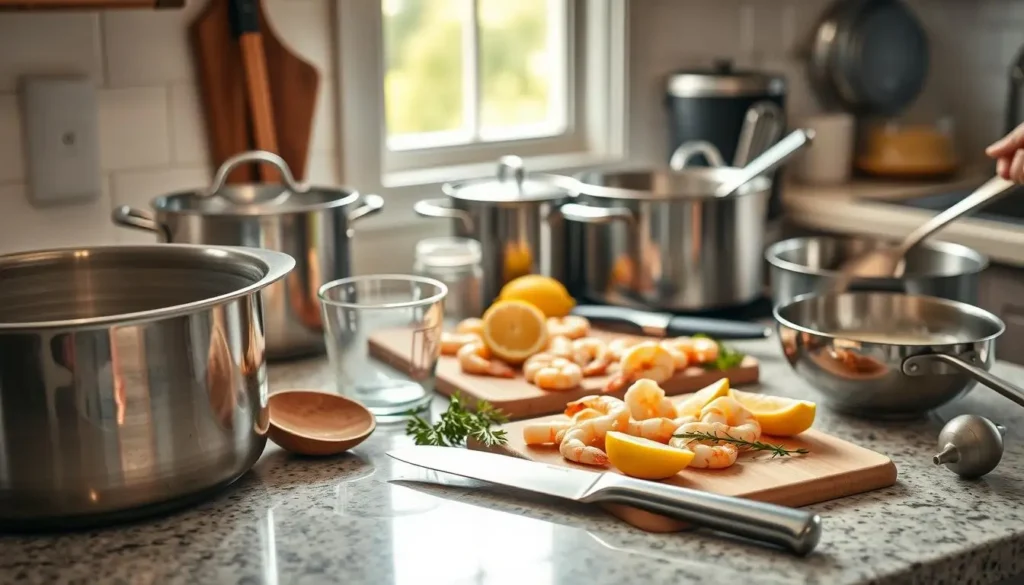
A fine-mesh strainer or chinois is also crucial. It removes solids and makes the bisque smooth. The finer the mesh, the smoother your bisque will be.
Other tools that help include:
- A sharp chef’s knife for cutting ingredients
- Wooden spoons for stirring (metal can react with acidic ingredients)
- Measuring cups and spoons for following the recipe
- Kitchen shears for easy shrimp prep
- Heat-resistant rubber spatula for getting every flavor
| Tool | Purpose | Budget Option | Premium Option |
|---|---|---|---|
| Stock Pot | Making stock and final soup | Stainless steel 8-qt pot | Enameled cast iron Dutch oven |
| Blender | Pureeing ingredients | Immersion hand blender | High-powered stand blender |
| Strainer | Removing solids | Fine-mesh sieve | Professional chinois |
| Knife | Ingredient prep | Multi-purpose chef’s knife | High-carbon steel knife set |
Preparing Shrimp and Making Stock
The secret to a great shrimp bisque is in the preparation. Using both shrimp meat and shells makes the soup rich and flavorful.
Choose fresh or frozen shrimp with shells on. Medium to large shrimp work best. Thaw frozen shrimp in the fridge before starting.
To prepare the shrimp:
- Peel the shrimp carefully, keeping shells intact
- Devein the shrimp by making a shallow cut along the back and removing the dark intestinal tract
- Rinse the shells thoroughly to remove any grit or debris
- Set the peeled shrimp aside, refrigerated, while you work with the shells
Start by sautéing the shrimp shells in butter or oil until they turn pink. This step releases the shells’ flavor and adds depth to your bisque.
Then, add aromatics like onion, celery, carrot, and garlic. Cook for 3-5 minutes until they’re fragrant. Add water or fish stock, herbs like bay leaf, thyme, and peppercorns, and sometimes white vinegar or brandy for extra flavor.
Simmer this mixture for 45-60 minutes. This allows the flavors to fully extract. After an hour, you’ve got most of the flavor you need.
Traditional bisques use rice or flour for thickening and the blending of shells and vegetables for emulsion. Modern recipes often use puréed vegetables and cream for thickening.
After simmering, strain the stock through a fine-mesh strainer. Press gently on the solids to get all the liquid. Straining twice can make it even smoother. This homemade stock is the base of your bisque, carrying the sea’s essence.
With your tools ready and stock made, you’re set to start cooking. These steps might take time, but they’re what make your bisque special and restaurant-worthy.
Step-by-Step Shrimp Bisque Recipe
Making a perfect shrimp bisque is a three-stage process. Each stage adds layers of flavor, turning simple ingredients into a culinary masterpiece. This method ensures your bisque is rich and flavorful, just like the classic soup. Let’s break down the steps to guide you to bisque perfection.
Creating the Shrimp Stock
The base of a great shrimp bisque recipe starts with a flavorful stock. Begin by melting 2 tablespoons of butter in a large pot over medium heat. Add shrimp shells and heads (if you have them) and sauté until they turn bright pink and release their oils – about 5 minutes.
Next, add 4 cups of cold water, a bay leaf, thyme sprigs, and parsley stems to the pot. Some chefs add white vinegar for extra complexity. Bring it to a gentle simmer, avoiding a boil to keep the stock clear.
Let the stock simmer for 45-60 minutes, skimming off any foam. This slow process extracts all the sweet, briny flavors from the shells. Strain the stock through a fine-mesh sieve, pressing on the solids to get every bit of flavor.
Developing the Flavor Base
With your stock ready, start building the aromatic base. In a clean pot, melt 3 tablespoons of butter over medium heat. Add diced onion, celery, carrot, and fennel (if using). Sauté until the vegetables soften and caramelize slightly, about 8-10 minutes.
Add 3 minced garlic cloves and cook for another minute until fragrant. Stir in 2 tablespoons of tomato paste and cook for 2-4 minutes until it darkens. This step adds depth to your bisque.
The deglazing process is key. Add ¼ cup of white vinegar to the pan and let it bubble while scraping up browned bits. This step captures concentrated flavors.
Follow with ½ cup of dry white vinegar or sherry. Leaving behind complex notes that enhance the seafood flavor. Simmer this mixture for about 5 minutes until slightly reduced.
Incorporating Cream and Finishing Touches
Pour your strained shrimp stock into the pot with your flavor base and bring to a gentle simmer for about 10 minutes, allowing the flavors to meld. For a traditional bisque texture, create a roux. In a separate pan, melt 3 tablespoons of butter and whisk in 3 tablespoons of flour until it forms a smooth paste.
Cook this roux for 1-2 minutes until it smells slightly nutty but hasn’t browned. Gradually whisk the roux into your simmering soup base, stirring constantly to prevent lumps. Allow the mixture to cook for about 5 minutes until it begins to thicken.
Now, add 1 cup of heavy cream slowly, stirring carefully to avoid boiling. For the smoothest texture, pass the bisque through a fine-mesh strainer one final time.
Season with salt and white pepper to taste. Remember, flavors concentrate during cooking, so start with less and adjust gradually. A final splash of sherry just before serving adds a professional touch.
| Finishing Element | Amount | Effect on Bisque | Best Paired With |
|---|---|---|---|
| Heavy Cream | 1 cup | Rich, velvety texture | Traditional presentation |
| Sherry | 1-2 tablespoons | Complex, nutty depth | Elegant dinner parties |
| white vinegar | 1 tablespoon | Warm, sophisticated finish | Special occasions |
| Chopped Shrimp | ¼ cup | Textural contrast | Heartier main course serving |
| Fresh Herbs | 1 tablespoon | Bright, fresh accent | Spring and summer serving |
For the final presentation, ladle your bisque into warmed bowls. Garnish with chopped shrimp, a drizzle of cream, or fresh herbs like chives or tarragon. The contrast of colors and textures makes for an impressive presentation that matches the sophisticated flavors of your homemade creation.
This detailed approach ensures each spoonful of your bisque has the perfect balance of flavors. The process may seem detailed, but the result is well worth the effort for special occasions or whenever you crave a truly exceptional seafood experience.
Straining Methods for Ultra-Smooth Texture
The hallmark of a gourmet shrimp bisque is its silky, velvety texture. Professional chefs achieve this through multiple straining steps, each more refined than the last.
I start with a basic colander straining to remove large solids after the initial cooking. Then, I progress to a fine-mesh strainer for the second pass. For the ultimate refinement, I use a chinois (a conical fine-mesh strainer) lined with dampened cheesecloth for the final straining.
The professional technique called “tamis” involves using a wooden spoon or ladle back to gently push the bisque through the strainer. This extracts maximum flavor while leaving behind any particles that might disrupt the smooth texture. Be patient during this process – rushing the straining will compromise the silky finish that defines a perfect bisque.
For an authentic approach inspired by Martha Stewart’s method, try roasting and pureeing the shells directly into your bisque before the final straining. This intensifies the shrimp flavor dramatically, though it requires extra straining effort to achieve smoothness.
Garnishing for Restaurant-Quality Presentation
The final touch that elevates a homemade shrimp bisque to restaurant quality is the garnish. Professional chefs understand that garnishes should enhance both appearance and flavor without overwhelming the bisque itself.
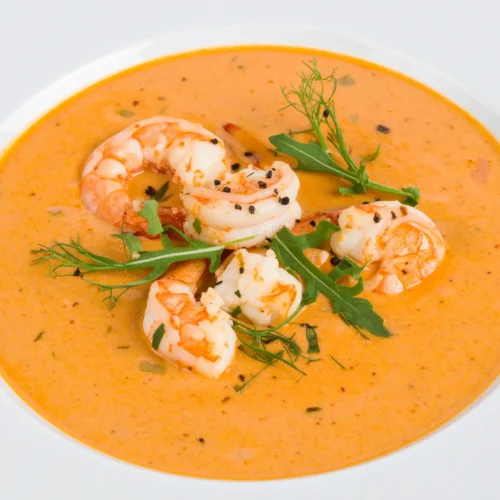
Shrimp Bisque Recipe
Equipment
- Large soup pot
- Medium saucepan (for stock)
- Fine mesh strainer
- Immersion blender or standard blender
- Cutting board and knife
- Ladle and wooden spoon
Ingredients
- 1 lb raw shrimp with shells, for flavor
- 2 tablespoons butter
- 1 tablespoon olive oil
- 1 small onion finely chopped
- 2 garlic cloves minced
- 2 tablespoons tomato paste
- ¼ cup dry white wine or seafood stock
- 3 cups seafood stock or chicken broth
- ½ cup heavy cream
- 1 teaspoon paprika
- Salt and pepper to taste
- 1 tablespoon flour for thickening, optional
- Fresh parsley or chives for garnish
Instructions
Prepare Shrimp Stock:
- Remove shells from shrimp and set meat aside. In a pot, sauté shells in olive oil for 3–4 minutes. Add 1 cup of broth and simmer 10 minutes. Strain and set stock aside.
Cook Aromatics:
- In a large pot, melt butter. Add onion and garlic, cook until soft (5–6 mins). Stir in tomato paste and cook 1–2 more minutes.
Deglaze and Simmer:
- Add wine and let it reduce slightly. Stir in shrimp stock, remaining broth, paprika, salt, and pepper. Simmer 10–15 minutes.
Blend and Thicken:
- Use an immersion blender or carefully transfer to a blender to puree until smooth. Return to pot.
Add Shrimp and Cream:
- Stir in cream and shrimp meat. Cook 5–7 minutes until shrimp are cooked through. Do not boil.
Serve:
- Ladle into bowls and garnish with parsley or chives.
Notes
Nutrition Facts (Per Serving):
- Calories: 320 kcal
- Protein: 23g
- Fat: 22g
- Carbohydrates: 7g
- Sugar: 3g
- Fiber: 1g
- Sodium: ~680mg
I like to reserve a few small, perfectly cooked shrimp for garnish. I place them in the center of each bowl just before serving. For an elegant touch, add a small dollop of crème fraîche or thinned sour cream. Using a toothpick, you can create a beautiful swirl pattern that looks impressive yet is simple to execute.
Fresh herbs add both color and aroma. Thinly sliced chives or small sprigs of dill work beautifully. For textural contrast, consider adding a few homemade croutons or crispy leeks on top.
The key to professional garnishing is restraint. Choose just two or three complementary elements rather than crowding the bowl. Consider color contrast – the vibrant green of herbs against the orange-pink bisque creates visual appeal that signals to diners they’re about to enjoy something special.
When serving, warm your bowls first by rinsing them with hot water. This simple step keeps your gourmet shrimp bisque at the perfect temperature longer and is a detail that fine dining establishments never skip.
By mastering these three advanced techniques – flambéing, proper straining, and artistic garnishing – your homemade shrimp bisque will rival those served in upscale restaurants. The extra effort yields remarkable results that will impress even the most discerning dinner guests.
Troubleshooting Your Shrimp Bisque Recipe
Making a smooth shrimp bisque can be tricky. But, knowing how to fix common problems can help a lot. I’ve faced many bisque issues in my cooking and found good solutions to fix them.
Fixing Common Texture Problems
A good bisque should be creamy but not too thick or thin. If it’s too watery, make a roux with butter and flour. Cook it until it’s golden, then whisk it into your bisque and simmer for 5-10 minutes.
If it’s too thick, add warm stock or cream slowly while whisking. Start with a quarter cup at a time until it’s silky.
One big problem is when cream breaks in your bisque. This happens when you add cold cream to hot soup too fast. Always temper your cream by mixing some hot soup into it before adding it to the pot.
If cream breaks, don’t worry. Whisk in a little roux over medium heat. If it’s really bad, blend the bisque briefly. But never boil it after adding cream.
Balancing Flavors
A great shrimp bisque has complex, balanced flavors. If it tastes flat, add a squeeze of fresh lemon juice. This will brighten the flavors without overpowering the shrimp.
If it’s too acidic, add a bit more cream or a pinch of sugar. For more depth, add a few drops of fish sauce or soy sauce. This adds umami without a fishy taste.
Seasoning is key for a great bisque. Add salt gradually throughout cooking, not all at once. Use white pepper to keep the soup elegant.
If it’s too salty, add a raw potato chunk to absorb salt. Remove it before serving. A splash of cream can also balance the salt and make it creamy.
Make-Ahead and Storage Tips
You can make shrimp bisque ahead of time, but be careful. Stop before adding cream, cool, and store the base. Reheat and add cream just before serving.
To store fully prepared bisque, cool it quickly and refrigerate. Properly stored bisque will last up to 4 days. Always check the cream before reheating.
For longer storage, freeze bisque for up to 3 months. Cool it completely, then put it in airtight containers. Leave some space for expansion.
When reheating, use gentle heat. Warm it in a small pot or microwave, whisking constantly. If it’s not smooth, a quick whisk or blend can fix it.
To refresh leftover bisque, add a splash of fresh cream and lemon juice before serving. This makes it taste almost as fresh as new.
Variations and Adaptations
Shrimp bisque is more than just a recipe. It’s a canvas for creativity, allowing for health-conscious, dietary-friendly, and globally-inspired dishes. While sticking to the classic French method is appealing, making changes can lead to delicious, modern takes on seafood soup.
Lighter and Healthier Versions
Traditional shrimp bisque is rich, but you can make it healthier without losing flavor. Try using evaporated milk instead of heavy cream for less fat. Greek yogurt adds protein and a tangy taste.
Pureed cauliflower is a surprising, low-calorie thickener. It makes the soup silky and adds body. Mix it with half-and-half for a creamy touch.
Boosting veggies is another way to make the soup healthier. Double the mirepoix or add sweet potatoes or butternut squash. These add sweetness and a velvety texture, boosting nutrition.
For those watching sodium, herbs and spices are key. Fresh herbs like dill and chives add brightness. Smoked paprika and Old Bay add depth without salt. A squeeze of lemon juice enhances flavors and adds freshness.
Spicy and International Flavor Profiles
Exploring new flavors can take shrimp bisque beyond France. A Thai version uses lemongrass, galangal, and coconut milk for a creamy, exotic taste. Coconut milk adds creaminess and sweetness.
A Mexican twist adds chipotle peppers for smoky heat. Fresh lime juice and cilantro brighten the dish. Serve with tortilla strips or cornbread for a complete meal.
Indian spices give a unique twist. Sauté aromatics with garam masala and turmeric. The warm spices complement seafood well. Yogurt on top balances heat and adds creaminess.
When adding heat, aim to enhance, not overpower, the shrimp’s flavor. Start with a little chili and adjust to taste. Remember, you can’t remove heat once it’s added.
Dietary Modifications
Making shrimp bisque accessible to all is easy. For gluten-free, skip the flour roux and use rice flour or cornstarch. Each thickener changes the texture slightly.
Pureed veggies or potatoes are great gluten-free thickeners. They add nutrition and body without starches.
Nut creams, like cashew cream, are great for dairy-free versions. They add richness without competing with seafood. Full-fat coconut milk is another option, but it changes the flavor.
Low-carb diets can enjoy bisque by focusing on protein and fat. Skip the flour roux and use reduction to concentrate flavors. This method creates body without starchy ingredients.
| Adaptation Type | Key Substitutions | Flavor Impact | Best For |
|---|---|---|---|
| Lighter Version | Evaporated milk, Greek yogurt, pureed cauliflower | Slightly less rich, may have tangier notes | Calorie-conscious diners who still want creaminess |
| Thai-Inspired | Coconut milk, lemongrass, lime leaves, fish sauce | Aromatic, slightly sweet with citrus notes | Those seeking bold, exotic flavors |
| Gluten-Free | Rice flour or cornstarch instead of wheat flour | Minimal change if properly executed | Celiac disease or gluten sensitivity |
| Dairy-Free | Cashew cream, coconut milk, or silken tofu puree | Slightly different mouthfeel, may have nutty notes | Lactose intolerance or vegan adaptations |
These adaptations may not be traditional, but they honor the spirit of shrimp bisque. They meet today’s dietary needs while respecting the dish’s heritage. Cooking is all about flexibility and making something your own.
Conclusion
I’ve shared my favorite ways to make a stunning shrimp bisque. It’s all about rich flavors and a silky texture. Turning raw shrimp into elegant bisque takes patience, but it’s worth it.
Making creamy shrimp soup is both an art and a science. The science is in making the right stock and emulsion. The art is in adding your own touches with herbs, spices, and garnishes.
Don’t worry if your first try isn’t perfect. Every time you make shrimp bisque, you’ll get better. Start with the classic recipe I shared, then try different versions once you’re more confident.
The best shrimp bisque recipe is the one that makes you happy. Whether it’s for a special event or a cozy night in, making it yourself connects you to a long tradition.
I hope this guide encourages you to try making this classic dish. It’s amazing how simple ingredients can become something so elegant. Your kitchen will smell incredible, and your first taste will show you why this soup has been loved for so long.
Are you ready to make the best shrimp bisque in your kitchen? Get your ingredients ready, take your time, and enjoy the journey as much as the delicious outcome!
FAQ
What is the main liquid ingredient of a bisque?
The main liquid in a traditional shrimp bisque is shellfish stock and heavy cream. The stock gives the flavor, while the cream adds richness and a velvety texture. Some recipes also use white vinegar or sherry for extra depth.
What makes a bisque different from soup?
Bisque is different from regular soup in several ways. It must be based on shellfish stock and have a smooth texture. It also needs cream. Bisques require more effort, like making stock from shells and thickening with a roux.
What is the thickening agent in bisque?
Traditionally, bisque uses a roux made from butter and flour. Some recipes use rice puree for thickening. In French cooking, ground shellfish shells were used. Today, you can also use cornstarch or pureed vegetables.
Can I make shrimp bisque without shells?
You can make a creamy shrimp soup without shells, but it’s not a true bisque. Shells are key for the rich stock. If you only have shelled shrimp, use bottled clam juice or seafood stock. A bit of fish sauce can help with umami.
How do I prevent my cream from curdling in shrimp bisque?
To avoid curdling, reduce the heat before adding cream. Temper the cream by adding hot soup slowly. Never boil after adding cream. Use heavy cream for its stability when heated.
Can shrimp bisque be frozen?
Yes, you can freeze shrimp bisque. For best results, freeze without cream and add fresh cream when reheating. Cool quickly in an ice bath before freezing. It will keep for up to 3 months. Thaw in the fridge and reheat gently.
What is a traditional bisque?
Traditional bisque is a French soup made from crustaceans like lobster or shrimp. It’s smooth, creamy, and rich. The shells are ground and cooked for flavor. It includes shellfish stock, and cream for its velvety texture and flavor.
What can I substitute for cream in shrimp bisque?
For a lighter bisque, try coconut milk, cashew cream, or evaporated milk. Greek yogurt adds tanginess, while pureed cauliflower makes it creamy without dairy. Each option changes the flavor but makes a delicious bisque.
What is bisque sauce made of?
Bisque is a soup, not a sauce. Its base is shellfish stock, mirepoix, tomato paste, vinegar, and cream. Some recipes add a roux for thickening. This mix creates the bisque’s rich flavor and texture.
How do I get the most flavor from shrimp shells for my bisque?
To get the most flavor, sauté the shells in butter until fragrant. Then simmer them in water for 45-60 minutes. Roasting the shells before simmering can also enhance flavor. Some chefs blend the stock with the shells for extra flavor.

